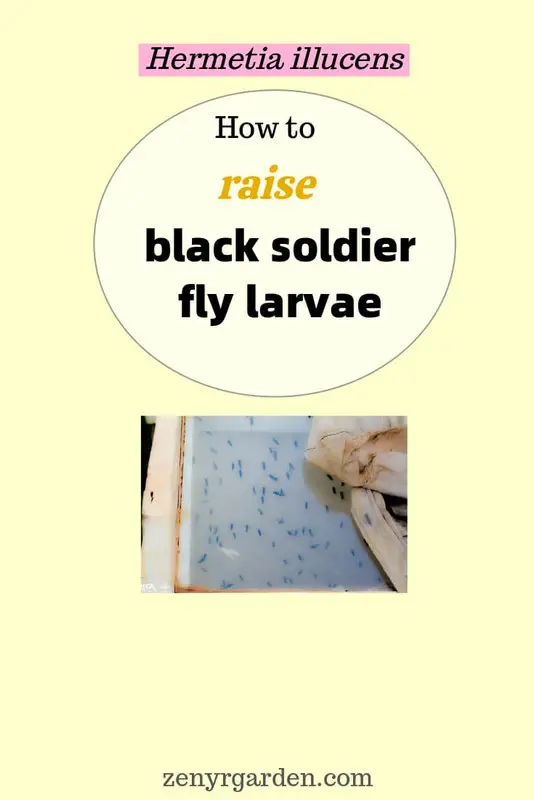If you get the larvae when they have already hatched, then you can get straight to the feeding stage. If you get the BSF started from eggs, then let's briefly see the hatching process together.
Step 1: Incubating the Eggs
To incubate BSF eggs, you can use a mix of chicken feed, pig feed or rice bran with water. The mix ratio 1:1 is good enough. For example, for 1 kilo of feed, mix in 1 kilo (or 1 liter) of water. The recommended moisture is 60-70% to hydrate the larvae & makes food easier to digest. You can mix in some more water depending on the local weather condition or if you see that the feed is too dry.
Put the eggs above the feed source, not directly touching it. Because coming into excess moisture may rot the eggs.
After 4-5 days, the eggs will hatch. The little hatchlings, which may be nearly invisible to the naked eyes at this stage, will crawl out of their nests & fall into the feed we've prepared. It's important at this point to keep the feed from drying out & hardening. Growers have noticed that the drying up issue tends to happen with chicken feed or rice bran. So remember to spray a little water on the feed during this process.
Here you can see the new hatchlings of BSF larvae. They are so tiny.
/new-hatchling-larvae-black-soldier-fly.jpg)
I have a full-detail How to incubate BSF eggs post here if you'd like a look later:
Let's see what to do next after these little guys hatch:
Step 2: After Eggs Hatch
For the first 3-4 days after the hatchlings hatch, they will still be very small. At this point, they will eat the food that we have in the bin for them. You can use soya bean waste, fruits, veggies, kitchen scraps, etc. We can let them enjoy the food there for the next 5 days. On day 4-5 or so, you'll see they grow significantly in size.
It's important at this stage to feed them with good, nutritive food. Keep the food moist but not too wet. Overly wet feed may drown the little larvae. Alternatively, you can start with something easy & fresh like zucchini or carrots. Then, we can boost it into more hardcore mode with fish, meat & other high-protein foods.
It's a bit hard to see but you can see the size difference compared to the newly hatched larvae. These ones are about 2-3 days old:
/two-day-old-larvae-black-soldier-flies.jpg)
When they are at this stage, it's a bit difficult to filter out their poop from the feed. It's good to scoop out the poop so the feeding area doesn't turn too hot. Some growers leave them in there & wait till they're a bit older to clean it out.
And next, as your BSF larvae are:
Step 3: Growing Bigger
The time between day 5 and day 10 is when the larvae eat most aggressively. They eat non-stop 24/24 hours a day. After the first 5 days in the feeding box where they hatch, we can then transfer the larvae to another feeding area that suits our needs. This really depends on everyone's purpose of raising the BSF larvae.
Here are some 5-day-old larvae. You can see they've grown quite a lot in size since.
/five-day-old-black-soldier-fly-larvae-size.jpg)
Let's have a closer look here. The little ones are still cream-like in color. The older ones about 10-15 days old will have a darker brown/charcoal color. This is a sign they are about to go to another stage, which is called the pupae stage.
/size-comparison-black-soldier-fly-larvae-five-ten-day-old.jpg)
At this point, you can freely decide what to do with your BSF larvae. Here are some common uses of BSF larvae & how you can keep raising them to suit your purpose:
Use #1: For Chicken Feed
In the first use case, if you're raising the larvae for chicken feed, then you may care less about the size of each one. Some people harvest the larvae when they're about 5-7 days old to feed little chicks. If you wait longer and feed them more (12-15 days old), the larvae will get bigger in size and weight.
You can feed the larvae with brewery grains, rice bran, barley, oats or whatever feed is available locally. At this point, some growers scoop 5-day-old or 7-day-old larvae out to weigh them to determine the amount of feed needed.
Because we don't worry much about their size for this purpose, you can try a starting 1:1 feeding ratio and increase as your food source supply fits.
For example, for 1 kg/lb of larvae (with initial feeding screened out) you can feed them with 1 kg/lb of soybean meal. The ratio works for any measuring units. Here are some brief numbers.
For 1 kg of larvae you can try feeding them daily with:
- 2 kg rice bran
- 3 kg old potatoes
- 4-5 kg soya bean paste
- 5 kg brewery grains + cassava
For 60-70 chickens, you can mix 3 kg of larvae with other greens, corn or grains. For chickens about 7-10 days old, we can start feeding them with these larvae so they'll get used to the taste.
It's good to feed baby chicks with smaller-sized larvae. But don't feed too much because the excess protein may cause diarrhea or white pooping. If you notice such condition, stop giving them larvae immediately.
If your raising conditions are good, from 50 grams of BSF eggs, you may get a yield of 200 kilos of larvae. When mixed with other feed components like greens & grains (at 1/3 amount for each component), this amount (200 kilos larvae) is more than enough to feed a flock of 10,000 chickens–considering each one eats about 100-120 grams (or 0.25-0.5 lb) per day.
For more details, I have a post here showing you 'How to feed chickens with Black soldier fly': https://zenyrgarden.com/how-to-feed-chickens-with-black-soldier-fly-larvae/
Alternatively, you can harvest your larvae:
Use #2: To Treat Bio-waste / To Compost
If you use BSF larvae to treat bio-waste, then we can ramp up the feeding ratio more comfortably. Because the bio-waste usually already comes from a free source.
You can try a ratio of 1:10. Indeed, one little larvae can eat up to 10x its weight. So 1 kg/lb of larvae can help you break down 10 kg/lbs of organic waste of garbage very efficiently. It's 1 to 10!
You can measure out 40 grams of 3- or 5-days-old larvae & pour them out on 400 grams (~1 lb) of waste. If you have a big compost box, put in about 166 kilos of old fruits, veggies, meat etc.
This will be enough to feed about 3 kilos of larvae for 3-4 days. Over 2 weeks, we can replace the food 3 times, totaling about half a ton of waste processed (166 kilo x 3 times = ~ half a ton).
With the 2-week-old larvae now, you can decide whatever to do with them. You can feed them live to the fish or further process them into fish food pellets. If you would like to use BSF for fish food pellets, you can make round-shape pellets to make it easy for the fish to swallow. Here is one good recipe:
- 35% BSF larvae
- 40% Cornmeal/soybean meal
- 25% Greens/carrots/cabbage
As doing it this way costs a huge amount of food (10x more) & energy, not a lot of smaller-scale growers will do it this way. But if you have a cheap, free food source for treating bio-waste & having the feed need for your pets, this is a good 2-in-1 solution (feed pet + treat waste).
To learn more about composting with BSF, you can check out here 'How to compost with Black Soldier Fly': https://zenyrgarden.com/how-to-compost-with-black-soldier-fly-larvae/
If you're looking to keep the BSF colony rolling, you can try use #3 which is:
Use #3: To Produce More Black Soldier Flies
When raising BSF larvae for further reproduction, growers usually feed them with high protein-content food. What they've noticed is that larvae fed with fruits, veggies or grains tend to grow slower & are smaller than those fed with meat or fish. The diet may also affect their strength & resistance. Some weak larvae that have turned black & pupated may die immediately afterwards.
If you're wanting to keep the BSF colony going, set aside some of your larvae for reproduction. For these guys, feed them with some more meat, fish or any high-protein foods. After about 2 weeks of feeding, the larvae will turn dark brown or charcoal & crawl out of the food box.
At this point, we can wait for about 3 weeks for them to fully turn into adult soldier flies. They need a dry, shaded place to dig under as they go through metamorphism. Be sure to give them a nice, shaded area on a dry substrate. Sand, sawdust or coco peat works great for this purpose.
They won't eat much anymore at this point. Because as the cream larvae turn black, they transform their mouth-parts into some sort of a closed hook-shaped structure. This helps them latch onto surfaces to inch out easily. You'll see some black larvae stop wiggling, elongate & just laying still at this point. It's completely normal & this means they're about to pupate.
When the flies get out of the shells, they'll naturally go find a light source. Within a short span of 7-8 days, they need to find a partner to mate. Good light source is the key for mating. It keeps their body temperature warm enough for reproduction & helps the male flies see the female when she pokes her tail out for mating.
After they've mated, the male flies will die. Soon after laying eggs, the female will also die. To get the eggs, you can prepare some wood stacks or cardboard pieces. Use an attractant that's smelly to attract the mother flies. When you get the eggs, you can begin incubating & start the whole cycle again.
Finally, there's one more little thing you can do with your BSF larvae:
Use #4: For Manure Management
If you combine raising BSF with raising chickens, quails or ducks, these little guys can help you process the manure into usable proteins & fats. The best thing of all is that they'll get it done in 1-2 hours and for a span of 2 weeks. It helps eliminate the odor very fast so there's no more stinky odor around the chicken coop.
Get Started Raising BSF!
So we've explored a few key points to keep in mind when raising black soldier fly larvae. It's not terribly difficult, but there are things that could go wrong. Be flexible & try experimenting with your local environment & food sources. Let us know if there's anything unclear or any ideas you'd like to share. Best of luck getting your colony rolling!
Credits:
Share or pin this post!


